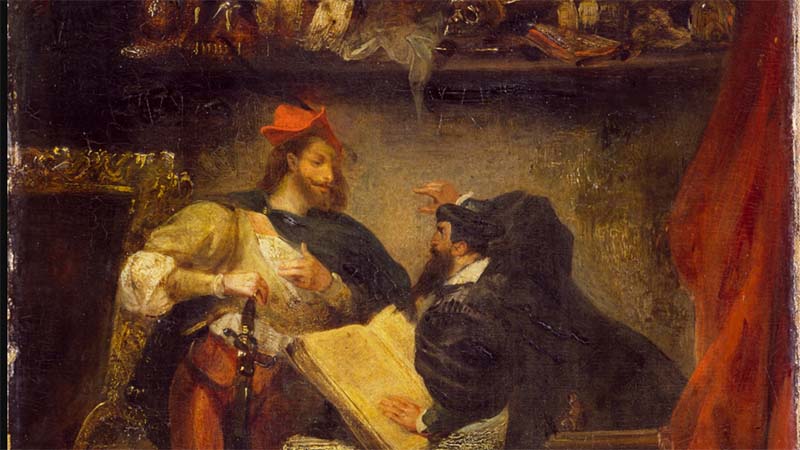I first read and finished, Faust (book 1) almost a year ago now. Then I got started on book 2, and after taking a deliberate amount of time—I was able to completely finish that one as well (from cover to cover). I held off on writing a review, because I really needed an extended period of reflection, whereby, I would be in a better position to fully absorb the unmatched depth of profundity that I had experienced after reading what I knew was like a revelation unto itself.
I remember as a ‘wee lad’ (about eighteen), when I was full of the intent curiosity along with the unpreparedness of that age that I first tried to tackle this project (book 1). I gave up after a few pages not because I didn’t like what I was reading, but because I knew even then that I was in way over my head at that time in my life—to fully comprehend the meaning or the objective of such a sublime work of creation as this one. And believe me, it is just that very thing.
Now, this is not going to be a review so much as I am going to attempt to make a brief exposition of just what Goethe was more than likely trying to achieve with his Faust: books 1 and 2.
There is a very interesting anecdote/curiosity in relation to Goethe’s Faust, that most knowledgeable people familiar with the subject could probably confirm. A very many individuals have read book 1, but not very many have read or attempted to read book 2. Especially, not in its entirety from cover to cover! Why?
It’s been readily acknowledged that even a great many ‘scholars’ included, have neglected or excluded book 2 of Faust a closer study and examination.
Therefore, the intended goal of my ‘exposition’ is to hopefully clarify all of the touched upon points that I have brought to bear. If I can demonstrate (to the interested reader), that book 2 is indispensable (i.e., because of its presumed irreconcilability to book 1), and greater than the ‘sum of its parts’ as any ‘holy work’ should be viewed/understood—then my efforts will not have been in vain. And yes, I say ‘holy’ not in the religious or theological sense, but purely from a sublimely ‘spiritual’ point of view.
Here’s a small excerpt that should suffice as an illustration. Keep in mind, Faust was written and conceived by Goethe as a classical metered poem (in 2 parts), that could also be staged like a play or simply be read like a novel, if you will.
From page 11, Prologue in Heaven:
(The Three Archangels come forward.)
Raphael.
The sun-orb sings, in emulation,
’Mid brother-spheres, his ancient round;
His path predestined through Creation
He ends with step of thunder-sound.
The angels from his visage splendid
Draw power, whose measure none can say;
The lofty works uncomprehended, Are bright as on the earliest day.
Okay, right! From the very opening verses/monologue there were already words of colossal ‘earth-shattering’ truth to adept ears! I’ll explain according to my own experience/understanding in relation to spiritual/esoteric principles.
The sun-orb sings (i.e., the Christ) in emulation,
’Mid brother-spheres, (i.e., the archangels and other beings in a lesser stage of evolution in relation to the Christ) his ancient round; (a stage or level attained in spiritual/cosmic evolution from a hierarchical perspective)
His path predestined through Creation (i.e., the Christ was a ‘forgone conclusion’ in the ‘mystery knowledge’ of the ancient mystery schools/centers of higher initiation)
He ends with step of thunder-sound. (i.e., the mission of the Christ will be finalized and fulfilled)
The angels from his visage splendid (i.e., the messengers of Christ, the archangels, however; a reference is also here being made to those select few mortal souls on the earth plane—who too will attain to the Christ consciousness)
Draw power, (i.e., from the lifeforce that is ‘love,’ from the Christ principle/the Christ impulse) whose measure none can say; (i.e., the Christ is the loftiest of the loftiest of cosmic beings/spirit in all of God’s creation) The lofty works uncomprehended, (i.e., the multitudes of mortals who remain uninitiated and blind to this most profound of cosmic wisdom/truth)
Are bright as on the earliest day. (i.e., the Christ and the meaning behind the mystery/revelation of creation remains unblemished untouched by the ‘illusion’ transpiring on the physical/earthly plane, since existence proceeds from the spiritual plane)
I could go on forever, but I think I made my point. I do want to stress that taken from the point of view that I’ve just proposed, part 1 of Faust should be understood as an allegorical tale which dramatized the preliminary stages of earthly evolution of the soul/spirit of one particular individual. In this case, that of one Doctor Faust. In other words, a soul that had reached the zenith of ‘material intelligence,’ and who had started to now question a ‘schema’ of a spiritual nature which he had yet to explore. For it is in the natural/sensual world that the human soul is first made ready for ‘initiation’ into a higher knowledge of existence.
It goes without saying, but this is one of the ‘greatest’ of the greatest of masterpieces in all of western literature ever conceived by human toil and imagination! And not since I read Dante’s, The Divine Comedy (the Jefferson Butler Fletcher translation) have I rediscovered verse/prose which is unsurpassed in human intellectual endeavoring that surely it had to have been written under the inspiration/influence of a supernal power.
BTW: I believe I have read the definitive English translation (translated in the original metres). This is the Bayard Taylor edition which was first published by Houghton, Mifflin and Company, Boston. The Riverside Press, Cambridge. 1883.
Faust: A Tragedy V1, by Johanne Wolfgang Von Goethe.
This 2010 Kessinger Legacy Reprints edition (Kessinger Publishing, LLC) is excellent! The font size can be small, but it’s bold and clearly visible and there were no blotches/anomalies that disrupted the flow of the text. There are extensive accompanying notes (books 1 and 2) from Taylor himself. This review is for the hardcover edition.
Love and Peace,
Carlos E Romero






0 Comments